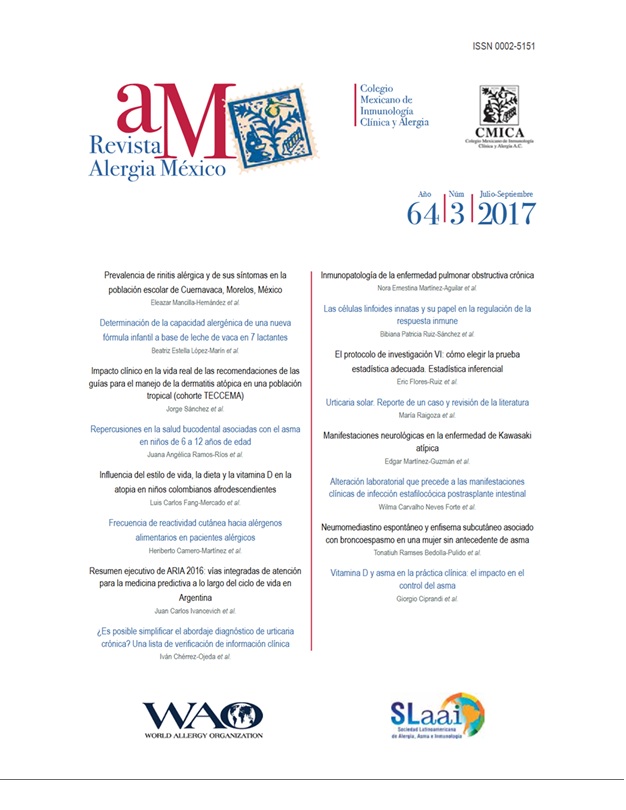Abstract
Background: Kawasaki disease (KD) is a type of systemic vasculitis of unknown etiology. Atypical Kawasaki disease is defined as that where there are signs and symptoms not corresponding to the classical criteria for this nosological entity. Children with atypical Kawasaki disease may present with acute abdominal symptoms, meningeal irritation, pneumonia or renal failure.
Clinical cases: We describe 4 children with ages ranging from 2 to 12 years who had atypical Kawasaki disease, with neurological and gastrointestinal symptoms as part of the systemic presentation of the disease. Treatment consisted of immunoglobulin and corticosteroids with good evolution.
Conclusions: KD is a systemic vasculitis that can involve many territories. Atypical manifestations can mislead the clinician and delay diagnosis. Pediatricians and sub-specialists should be aware of these neurological manifestations in order to provide adequate and opportune treatment.
References
Cimaz R, Sundel R. Atypical and incomplete Kawasaki disease. Best Pract Res Clin Rheumatol. 2009;23(5):689-697. DOI: http://dx.doi.org/10.1016/j.berh.2009.08.010
Levy M, Koren G. Atypical Kawasaki disease: Analysis of clinical presentation and diagnostic clues. Pediatr Infect Dis J. 1990;9(2):122-126.
Yun SH, Yang NR, Park SA. Associated symptoms of Kawasaki disease. Korean Circ J. 2011;41(7):394-398. DOI: http://dx.doi.org/10.4070/kcj.2011.41.7.394
Alves NR, Magalhães CM, Almeida RF, Santos RC, Gandolfi L, Pratesi R. Prospective study of Kawasaki disease complications: Review of 115 cases. Rev Assoc Med Bras. 2011;57(3):295-300. DOI: http://dx.doi.org/10.1590/S0104-42302011000300012
Amano S, Hazam F. Neural involvement in Kawasaki disease. Acta Pathol Jnp. 1980;30(3):365-373. DOI: http://dx.doi.org/10.1111/j.1440-1827.1980.tb01331.x
Mantadakis E, Tsalkidis A, Paraskakis E, Papadopoulou-Legbelou K, Varlamis G, Evangeliou A, et al. Anticonvulsant hypersensitivity síndrome closely mimicking Kawasaki disease. BMJ Case Rep. 2009; DOI: http://dx.doi.org/10.1136/bcr.10.2008.1076
Chinen J, Piecuch S. Anticonvulsant hypersensitivity syndrome vs Kawasaki disease: A challenging clinical diagnosis with therapeutic implications. Clin Pediatr (Phila). 2000;39(2):109-111. DOI: http://dx.doi.org/10.1177/000992280003900206
McCrindle BW, Wood RA, Nussbaum AR. Henoch-Schönlein syndrome. Unusual manifestations with hydrops of the gallbladder. Clin Pediatr (Phila). 1988;27(5):254-256. DOI: http://dx.doi.org/10.1177/000992288802700509
Hashimoto A, Matsushita R, Iizuka N, Kimura M, Matsui T, Tanaka S, et al. Henoch-Schönlein pupura complicated by perforation of the gallbladder. Rheumatol Int. 2009;29(4):441-443. DOI: http://dx.doi.org/10.1007/s00296-008-0727-0
Colomo-Padilla AL, Solórzano-Morales SA, Mora-Tizcareño MA, Sorcia-Ramírez G, Garrido-García LM. Perforación de la vesícula biliar asociada con hydrops vesicular como manifestación atípica de la enfermedad de Kawasaki. Informe de un caso. An Radiol Mex. 2015;14(1):123-128.
Sty JR, Starshak RJ, Gorenstein L. Gallbladder perforation in a case of Kawasaki disease: Image correlation. J Clin Ultrasound. 1983;11(7):381-384. DOI: http://dx.doi.org/10.1002/jcu.1870110708

This work is licensed under a Creative Commons Attribution-NonCommercial 4.0 International License.
Copyright (c) 2017 Revista Alergia México

